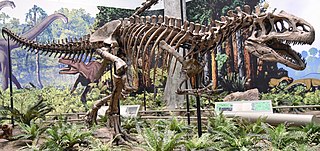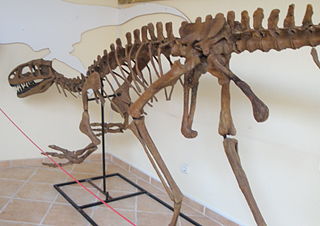
Tetanurae is a clade that includes most theropod dinosaurs, including megalosauroids, allosauroids, tyrannosauroids, ornithomimosaurs, compsognathids and maniraptorans. Tetanurans are defined as all theropods more closely related to modern birds than to Ceratosaurus and contain the majority of predatory dinosaur diversity. Tetanurae likely diverged from its sister group, Ceratosauria, during the late Triassic. Tetanurae first appeared in the fossil record by the Early Jurassic about 190 mya and by the Middle Jurassic had become globally distributed.

Afrovenator is a genus of megalosaurid theropod dinosaur from the Middle or Late Jurassic Period on the Tiourarén Formation and maybe the Irhazer II Formation of the Niger Sahara region in northern Africa. Afrovenator represents the only properly identified Gondwanan megalosaur, with proposed material of the group present in the Late Jurassic on Tacuarembó Formation of Uruguay and the Tendaguru Formation of Tanzania.

Carcharodontosauridae is a group of carnivorous theropod dinosaurs. In 1931, Ernst Stromer named Carcharodontosauridae as a family, which, in modern paleontology, indicates a clade within Carnosauria. Carcharodontosaurids include some of the largest land predators ever known: Giganotosaurus, Mapusaurus, Carcharodontosaurus, and Tyrannotitan all rivaled Tyrannosaurus in size. Estimates give a maximum weight of 8–10 metric tons for the largest carcharodontosaurids, while the smallest carcharodontosaurids were estimated to have weighed at least 500 kilograms (1,100 lb).

Allosauridae is a family of medium to large bipedal, carnivorous allosauroid theropod dinosaurs from the Late Jurassic. Allosauridae is a fairly old taxonomic group, having been first named by the American paleontologist Othniel Charles Marsh in 1878. Allosaurids are characterized by an astragalus with a restriction of the ascending process to the lateral part of the bone, a larger medial than lateral condyle, and a horizontal groove across the face of the condyles.

Chilantaisaurus is a genus of large theropod dinosaur, possibly a neovenatorid or a primitive coelurosaur, from the Late Cretaceous Ulansuhai Formation of China. The type species, C. tashuikouensis, was described by Hu in 1964.

Megalosauridae is a monophyletic family of carnivorous theropod dinosaurs within the group Megalosauroidea. Appearing in the Middle Jurassic, megalosaurids were among the first major radiation of large theropod dinosaurs. They were a relatively primitive group of basal tetanurans containing two main subfamilies, Megalosaurinae and Afrovenatorinae, along with the basal genus Eustreptospondylus, an unresolved taxon which differs from both subfamilies.

Megaraptor is a genus of large theropod dinosaur that lived in the ages of the Late Cretaceous. Its fossils have been discovered in the Patagonian Portezuelo Formation of Argentina, South America. Initially thought to have been a giant dromaeosaur-like coelurosaur, it was classified as a neovenatorid allosauroid in previous phylogenies, but more recent phylogeny and discoveries of related megaraptoran genera has placed it as either a basal tyrannosauroid or a basal coelurosaur with some studies still considering it a neovenatorid.

Monolophosaurus is an extinct genus of tetanuran theropod dinosaur from the Middle Jurassic Shishugou Formation in what is now Xinjiang, China. It was named for the single crest on top of its skull. Monolophosaurus was a mid-sized theropod at about 5–5.5 metres (16–18 ft) long and weighed 475 kilograms (1,047 lb).

Piatnitzkysaurus is a genus of megalosauroid theropod dinosaur that lived approximately 179 to 177 million years ago during the lower part of the Jurassic Period in what is now Argentina. Piatnitzkysaurus was a moderately large, lightly built, bipedal, ground-dwelling carnivore that could grow up to 6.6 m (21.7 ft) long.

Megalosauroidea is a superfamily of tetanuran theropod dinosaurs that lived from the Middle Jurassic to the Late Cretaceous period. The group is defined as Megalosaurus bucklandii and all taxa sharing a more recent common ancestor with it than with Allosaurus fragilis or Passer domesticus. Members of the group include Spinosaurus, Megalosaurus, and Torvosaurus. They are possibly paraphyletic in nature with respect to Allosauroidea.

Metriacanthosauridae is an extinct family of allosauroid theropod dinosaurs that lived from the Middle Jurassic to the Early Cretaceous. When broken down into its Greek roots, it means "moderately-spined lizards". The family is split into two subgroups: Metriacanthosaurinae, which includes dinosaurs closely related to Metriacanthosaurus, and another group composed of the close relatives of Yangchuanosaurus. Metriacanthosaurids are considered carnosaurs, belonging to the Allosauroidea superfamily. The group includes species of large range in body size. Of their physical traits, most notable are their neural spines. The records of the group are mostly confined to Asia, though Metriacanthosaurus is known from Europe. Metriacanthosauridae is used as a senior synonym of Sinraptoridae.

Allosauroidea is a superfamily or clade of theropod dinosaurs which contains four families — the Metriacanthosauridae, Allosauridae, Carcharodontosauridae, and Neovenatoridae. Allosauroids, alongside the family Megalosauroidea, were among the apex predators that were active during the Middle Jurassic to Late Cretaceous periods. The most famous and best understood allosauroid is the North American genus Allosaurus.

Lourinhanosaurus was a genus of carnivorous theropod dinosaur that lived during the Late Jurassic Period (Kimmeridgian/Tithonian) in Portugal. It is one of many large predators discovered at the Lourinhã Formation and probably competed with coeval Torvosaurus gurneyi, Allosaurus europaeus, and Ceratosaurus.
Thomas Richard Holtz Jr. is an American vertebrate palaeontologist, author, and principal lecturer at the University of Maryland's Department of Geology. He has published extensively on the phylogeny, morphology, ecomorphology, and locomotion of terrestrial predators, especially on tyrannosaurids and other theropod dinosaurs. He wrote the book Dinosaurs and is the author or co-author of the chapters "Saurischia", "Basal Tetanurae", and "Tyrannosauroidea" in the second edition of The Dinosauria. He has also been consulted as a scientific advisor for the Walking with Dinosaurs BBC series as well as the Discovery special When Dinosaurs Roamed America, and has appeared in numerous documentaries focused on prehistoric life, such as Jurassic Fight Club on History and Monsters Resurrected, Dinosaur Revolution and Clash of the Dinosaurs on Discovery.

Avetheropoda, or "bird theropods", is a clade that includes Carnosaurs and coelurosaurs to the exclusion of other Dinosaurs.

Neovenatoridae is a proposed clade of carcharodontosaurian dinosaurs uniting some primitive members of the group such as Neovenator with the Megaraptora, a group of theropods with controversial affinities. Other studies recover megaraptorans as basal coelurosaurs unrelated to carcharodontosaurs. Other theropods with uncertain affinities such as Gualicho, Chilantaisaurus and Deltadromeus are also sometimes included.

Megaraptora is a clade of carnivorous theropod dinosaurs. Its derived members, the Megaraptoridae are noted for their large hand claws and powerfully-built forelimbs, which are usually reduced in size in other large theropods.

Averostra, or "bird snouts", is a clade that includes most theropod dinosaurs, namely Ceratosauria and Tetanurae, and represent the only group of post-Early Jurassic theropods. Both survived into the Cretaceous period. When the Cretaceous–Paleogene extinction event occurred, ceratosaurians, megaraptorans an incertae sedis group within Tetanurae, and two groups of tetanurans within the clade Coelurosauria, the Tyrannosauroidea and Maniraptoriformes, were still extant. Only one subgroup of Maniraptoriformes, Aves, survived the extinction event and persisted to the present day.

Piatnitzkysauridae is an extinct family of megalosauroid or basal allosauroid dinosaurs. It only consists of three to four known dinosaur genera: Condorraptor, Marshosaurus, Piatnitzkysaurus and possibly Xuanhanosaurus. The most complete and well known member of this family is Piatnitzkysaurus, which also gives the family its name.

Orionides is a clade of tetanuran theropod dinosaurs from the Middle Jurassic to the Present. The clade includes most theropod dinosaurs, including birds.





































